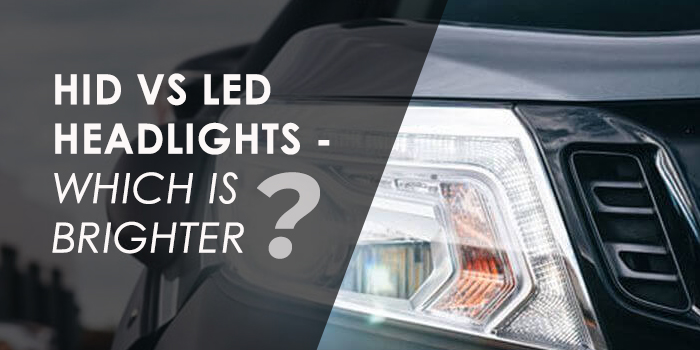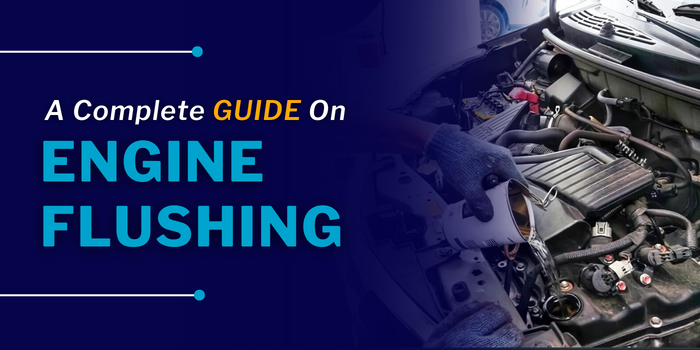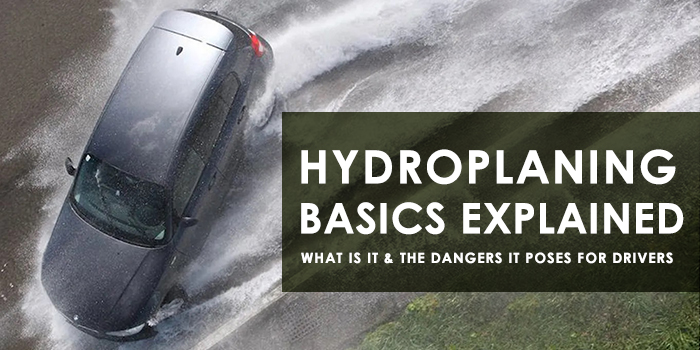
Have you ever been driving down a wet road when you momentarily lose control as the steering goes light and fails to react to your inputs? You most likely have encountered hydroplaning. But what is hydroplaning and what are the dangers it poses?
Hydroplaning is used to describe the process of vehicle tyres losing contact with the road surface over a wet patch which results in skidding or sliding. Car tyres have treads and grooves that are designed to push water out of the way so that the rubber can make contact with the road and provide traction. When the treads are worn out, a thin film of water separates the tyre from the road surface and you will not be able to steer the vehicle, brake effectively or use the throttle.
What is hydroplaning?
Vehicle tyres are made of rubber and consist of deep grooves that are designed to channel water from the road surface in order for the tyres to make contact with the tarmac. When there is more water than the tyre can disperse during contact, hydroplaning occurs when the tyres skid upon the surface of the water.
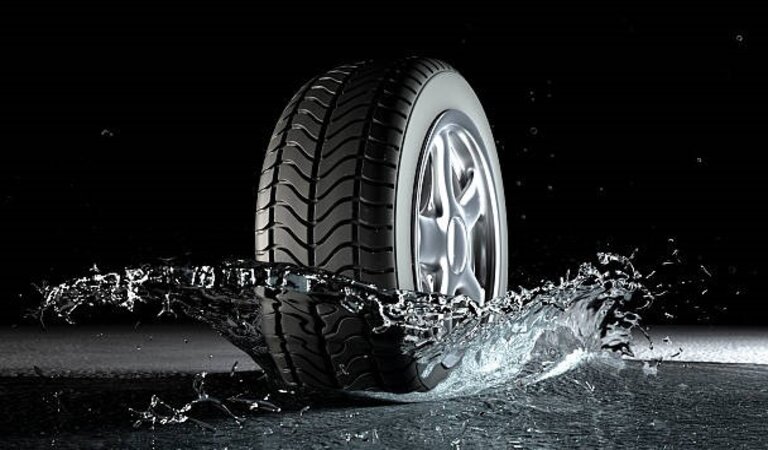
What does hydroplaning mean? With the tyres riding on a thin film of water, they cannot provide friction, resulting in loss of steering control and inability to use the brakes. If you happen to perform a jerky steering manoeuvre or step on the brakes too hard at this point, it could cause the vehicle to spin or veer off the road leading to an accident or rollover. Hydroplaning is usually caused by worn-out tyres driving over a wet surface.
Also read Things You Should Know About Tread Patterns Before Installing a Tyre
Conditions that cause hydroplaning
What is hydroplaning in driving? Hydroplaning usually occurs when there is a short drizzle or light rain that covers the road surface with a wet film of water. Roads are made from asphalt that releases an oily residue occasionally because the constituents of tarmac come from crude oil. This makes the road surface quite slippery for fast-moving vehicles and with rain, this could lead to a combination of hydroplaning and lack of traction.

There is a high chance of an accident when it is raining, snowing or the road is filled with ice. Having tyres that are worn out only increases the chances of an accident due to inadequate traction. However, if you drive cautiously, use tyres in good condition and don’t overspeed, the chances of hydroplaning are greatly reduced.
Also checkout Retreading Tires : Is It Safe For Your Vehicle?
Steps to avoid hydroplaning
Hydroplaning definition states that tyres lose traction with the road surface due to a thin film of water resulting in skidding and loss of control of the vehicle. Hydroplaning may occur when the tyres are worn out and the grooves or treads can no longer push the water out of the way.
Also read tyre construction and its parts
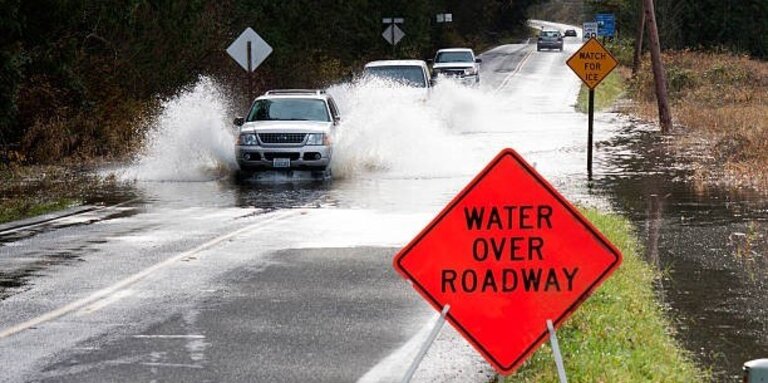
Here are some steps you can follow in order to avoid hydroplaning:
- Hydroplaning can be helped by driving cautiously and avoiding any sudden steering inputs. Use the throttle and the brakes in a gentle manner. If you feel the steering go loose, don’t panic. If you keep the vehicle stable, there is less chance of you losing complete control.
- Keep the vehicle in low gear and drive slowly. Over speeding in higher gears is a recipe for disaster because if the vehicle drifts off the road, it will be that much harder to steer in the right direction.
- Avoid using cruise control or automatic driving aids. You need to be in control of the throttle and it should be used judiciously. However, keep the electronic traction control on to prevent the vehicle from losing stability.
- Cars driving in front of you clear the road of water and leave wheel tracks that you can follow. There is less chance of your vehicle skidding because the car tyres can make good contact with the road.
- Try driving in the inner lanes where there is no water accumulation. When it rains, the outer lanes get filled with water and driving on them could increase your chances of aquaplaning.
- If you notice any patches of water or puddles, proceed with caution because you are likely to lose control in these areas. Don’t slam on the brakes to avoid them, instead drive in a defensive manner and be prepared for any unforeseen circumstances.
- The grooves in tyre treads are used to push water out of the way on a wet road surface. The faster you drive, the harder the tyres will have to work to disperse the water. Drive slowly so that you don’t hydroplane on a wet patch.
- Ensure that tyres are inflated to the recommended tyre pressure. Underinflated tyres do not effectively disperse water and are prone to hydroplane. Overinflated tyres have poor grip and don’t provide enough confidence while driving. Tyres inflated to the right pressure keep the vehicle in control at all speeds.
- Rotate your tyres on a regular basis for even wear and stable driving. If tyres are worn out, replace them immediately as it is unsafe to drive in wet conditions with worn-out tyres.
- When you compare vehicles with the same tyre size and type of tyre, the vehicle with greater weight has an advantage because it creates more force between the tyre and the road, thereby decreasing the chance of hydroplaning on a wet surface.
How do you deal with hydroplaning when it occurs?
Modern cars have a host of automatic traction controls that make sure the vehicle remains stable in all driving conditions. The car’s computer will immediately cut power to the skidding wheel and use ABS with EBD (automatic braking system with electronic brake force distribution) to bring the vehicle to a controlled stop if it starts to drift off course. There are also sensors that monitor if you are drifting out of the lane and will warn the driver before the situation becomes worse.
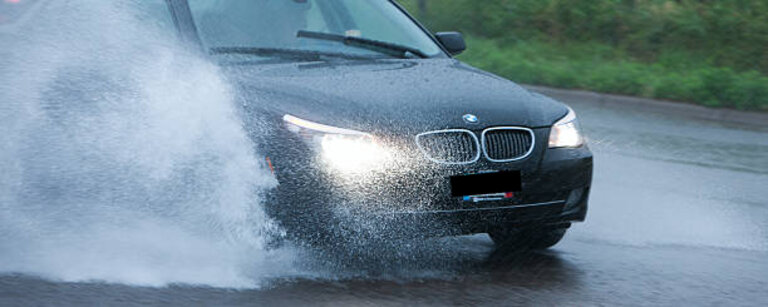
Despite all these electronic aids and advanced technology, it is possible that your vehicle will hydroplane. You should be prepared for the situation by keeping calm and avoiding any sudden recovery moves. If you feel the steering going loose and notice the vehicle is skipping towards the kerb, gently lift off the throttle and slowly turn the wheel in the right direction. Lightly tap the brakes to reduce speed and steer the car back onto the road.
Also read What Is Tire Regrooving? Know Its Advantages
Use smooth movements and keep steering until you feel the tyres gripping the road. Hydroplaning usually lasts for a few seconds and you should be able to recover beyond this point. As the vehicle speed decreases, the tyres will automatically regain traction and you will be able to steer the vehicle. Again, your tyres must be in good condition and inflated to the correct pressure, otherwise, the result of a hydroplaning incident may send the vehicle spinning out of control.
Being prepared for such a situation reduces the likelihood of an accident and keeps you and your passengers safe.
Also Checkout Low Profile Tyres Vs Normal Tyres Vs High Profile Tyres
Is hydroplaning and aquaplaning the same thing?
In the United States, the term usually used for skidding on a wet surface is called hydroplaning, while in Europe and Asia, it is known as aquaplaning. Vehicle manuals often cite hydroplaning or aquaplaning and advise drivers to proceed with caution while it is raining or snowing. Roads are usually designed to prevent water from stagnating in the lanes, instead, the water runs off the edges into the drains. This is known as road banking. Avoid driving on the outer lanes during inclement weather as this is where water has a high chance of accumulation. Stick to the inner lanes and drive at slow speeds with caution.
If you are aware of an impending thunderstorm or rainy weather, it would be best to postpone your journey until the weather clears up. Plan your road trip accordingly because it is always safer to drive on dry roads. Calculate your risks before you head out in your vehicle.
Also read Tip and Tricks for Preventing a Car Tire Blowout
Conclusion
Hydroplaning is a phenomenon that occurs when the vehicle’s tyres cannot push water out of the way fast enough, and they end up riding on a film of water without making contact with the road. The vehicle starts to skid and the driver can lose control in a matter of seconds. If the car is moving fast enough, it may breach the median or spin endangering the lives of the driver and passenger as well as other motorists.
The main factors that cause hydroplaning are the speed of the vehicle, the depth of the water puddle and the amount of tread on the tyres. That is why it is always important to drive slowly in wet conditions and use tyres that are in good condition.
It is not always easy to identify when your car is hydroplaning other than the rear end getting unstable, the steering going light and the vehicle drifting out of its lane and ignoring corrective steering inputs. If this starts to happen, slow down, steer in the right direction and most of all don’t panic. The vehicle should regain composure in a few seconds.
Just remember to keep your tyres in good condition, inflate them to the right pressure, drive cautiously and at an appropriate speed when raining and follow the steps mentioned to avoid hydroplaning.
This article explained hydroplaning driving in detail and attempts to keep drivers informed about emergency situations. Other articles that may be of interest to you include Confused About Which Tyre to Buy for Your Car? Read This!!! and 9 Amazing Methods to Reduce Tyre Noise While Driving or visit Carorbis Blog for more.
Frequently Asked Questions
Q1. What increases the chances of hydroplaning?
Ans. The three main factors that contribute to hydroplaning include vehicle speed, vehicle weight, tyre pressure, amount of water on the road, and tyre condition. As the car speed increases, the traction reduces on wet surfaces increasing the chances of hydroplaning. If there is a large amount of water on the road, hydroplaning will occur because of the film of water between the tyre and the tarmac. When tyres are underinflated, the tread is not able to push water out causing them to skid on the wet surface. Overinflated tyres do not provide a large contact patch with the road, therefore decreasing traction. The best way to avoid hydroplaning is to drive slowly, avoid patches of water and keep the tyres in good condition and at the proper tyre pressure.
Q2. Are there special tyres designed to prevent hydroplaning?
Ans. Special tyres are designed to be used in wet conditions with a low risk of hydroplaning. Manufacturers like Goodyear, Pirelli, Bridgestone and Yokohama all manufacture tyres with tread patterns that evacuate water from the tyre contact patch. Tyre types include:
Touring – provide superior ride comfort and handling, low noise when driving at high speeds, and excellent traction for all seasons. The tread pattern includes special slots and grooves that provide grip in wet and snowy conditions.
Performance – tyres which provide maximum traction around corners, under heavy braking and while accelerating. These tyres are available in all-season variants that resist hydroplaning and can be driven on icy roads with confidence.
Hydroplaning can be a risky situation for drivers, but when equipped with the right tyres and with defensive driving techniques, you can have a hassle-free drive in all weather conditions.
Q3. At what speeds does hydroplaning occur?
Ans. Hydroplaning can occur at various speeds depending on the condition of the road, tyre treads and depth of the water on the tarmac. In any case, driving at slow speeds will reduce the chances of hydroplaning because there is more friction between the tyre and the road at slower speeds. Driving at speeds below 55 km/h will give the driver more time to react to a skid and will decrease the chances of hydroplaning and losing control of the vehicle.
Q4. How do I know my car is hydroplaning?
Ans. Hydroplaning gives the effect of skidding or drifting on the road, with the steering feeling light as if you are driving on ice. The rear of the vehicle may begin to fishtail and the rev counter may jump up as the tyres spin without proper traction. Gently lift off the throttle and steer the vehicle in the right direction without any sudden moments to avoid an accident.

